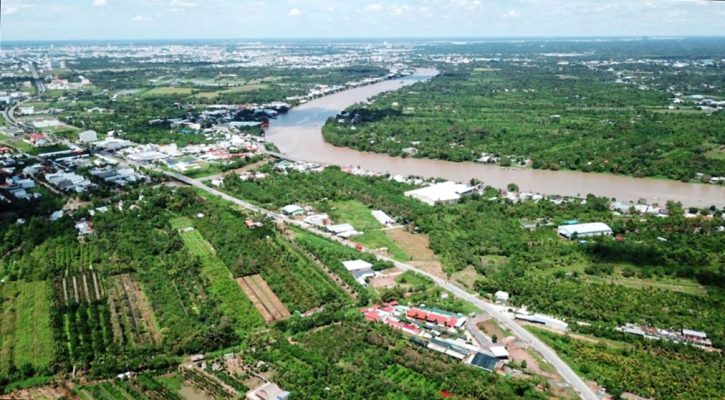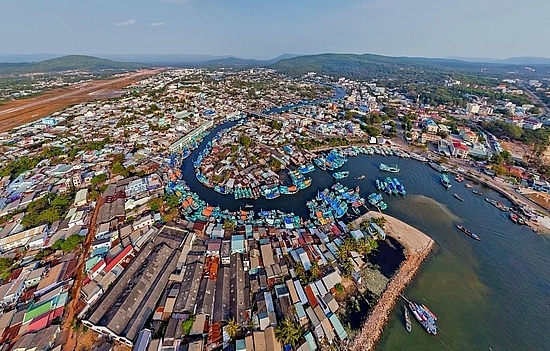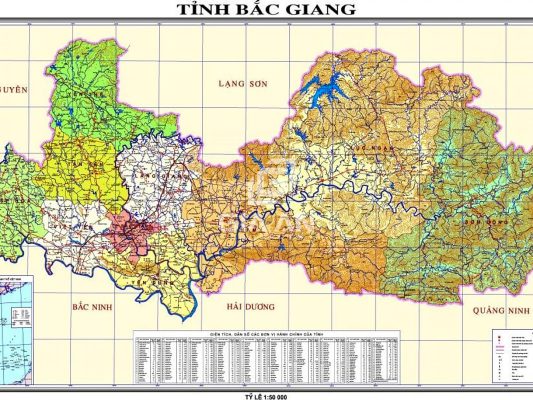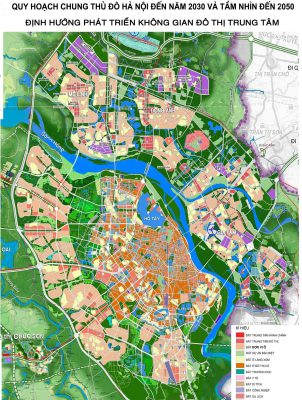This is the opinion of the President of the Vietnam Urban Development Planning Association to serve the National Assembly’s monitoring program on the implementation of policies and laws on planning work since the Law on Planning took effect.

Should it be that instead of making a national master plan, only a national master development strategy should be drawn up, based on the strategies of the ministries and branches?
In 2017, the Law on Planning was born and officially took effect on January 1, 2019. After more than 3 years of implementation of the Law on Planning, a number of shortcomings and limitations in the implementation of the formulation, appraisal, decision/approval of national, regional and provincial plans have been revealed in the localities. method, specifically:
1- About the National Master Plan
According to the provisions of the Law on Planning, the formulation of a national master plan is to ensure the consistency, synchronization and articulation of the planning system throughout the country. It is a synchronous connection between the national master plan – the sectoral plan – the national marine spatial plan, to serve as a basis for regional and provincial planning.
According to Article 6 of the Law on Planning, the formulation of “planning components” must be consistent with superior master plans such as national master plans, national marine spatial planning, sectoral planning, regional planning, etc. The national master plan that has not yet been issued will lack grounds for approving regional and provincial plans. This is the bottleneck that has been more than 3 years of implementation of the Planning Law until now, only a specialized plan, a regional plan and a provincial plan have been approved.
The Planning Law that took effect from January 1, 2019 also means that the previous specialized Planning Laws will expire, while the plans implemented under the new Planning Law have not yet existed, causing a lot of problems. difficult for projects. Many master plans have been completed but cannot be adjusted, supplemented and approved in accordance with specialized laws, but must submit new procedures under the Law on Planning. Therefore, it has caused congestion affecting investment and development.
Having to wait for the national master plan to be approved before formulating regional and provincial plans will not ensure the required progress for the 2021-2030 period. To meet this requirement, the provincial planning of 63 provinces and cities and the national master plan must be implemented in parallel and at the same time. However, the formulation of a national master plan by integrating sectoral and construction plans requires a lot of time and resources. In addition, it will be very difficult to adjust, if there is a change in strategic goals, in the face of impacts such as climate change, epidemics (such as the COVID-19 pandemic), the development of science and technology. … or political fluctuations in the world. Thus, the adjustment process will certainly take a lot of time and money.
On the other hand, this new type of Master Plan has little (or no) conformity with international practices, leading to overlap between the types of planning.
Construction planning (defined in the Law on Construction 2014) is a type of physical planning, which is the arrangement and spatial distribution of socio-economic, defense and security activities associated with structural development. infrastructure, resource use and environmental protection in a defined territory, in order to effectively use the country’s resources and serve sustainable development goals in the planning period.
The national master plan is essentially an intangible plan, through the current status and development forecast of the development index of the region, the country, the index of population, labor and other data. for agriculture, industry, tourism, service… integrated with physical planning such as construction planning.
Therefore, instead of making a national master plan, should only develop a national master development strategy, based on the strategies of ministries and sectors, for example, the development strategy of Vietnam’s transportation, national strategy on housing development, national strategy on clean water supply…. Thus, it will be flexible in the process of directing and can be implemented immediately. Like before, we often develop socio-economic development plans for each period that are both easy to direct and implement and easy to adjust. The adjustment of an approved National Master Plan would be a very time consuming and complicated task, while the possibility of having to adjust the National Master Plan is very likely in the face of fluctuations such as: analyzed above. Therefore, choosing to develop an alternative strategy for planning will be more proactive in the implementation process.
Another shortcoming in the implementation of the Planning Law when developing a national master plan is the lack of a “conductor” and the head of each sector responsible for acting as the focal point for articulation, coordination and direction. what to do first, which to do later to create a chain reaction in a positive direction. Only in this way can the potentials and strengths of the industries be promoted in the process of socio-economic development, spatial and territorial development, and mutual support for mutual development.
2- About regional planning
Also according to the Law on Planning, we have to make 06 regional plans for 6 socio-economic regions. That is the Northern Midlands and Mountains; The Red River Delta; North Central Region and Central Coast; Highland; Southeast region; and the Mekong Delta region. Currently, only the Mekong Delta Master Plan has been approved.

The Mekong Delta region is the first regional planning in our country to be formulated according to the Law on Planning. Internet photos
This is the first regional planning in our country formulated under the Law on Planning, aiming to integrate all contents of socio-economic development, spatial development, urban and rural system in a large territory. big. This is a plan that has been elaborately and scientifically researched, has given development orientations and serves as a legal basis for provincial planning work of 13 localities in the whole region. Through the Mekong Delta planning, the spatial organization and development direction of the sectors and fields within the territory of the region will be concretized and connected, unified and synchronous, becoming a tool for implementation. State management function to implement lower-level plans in a practical and effective manner.
However, because the national master plan has not been prepared and approved, the Master Plan for the Mekong Delta region this time (approved Decision No. 287/QD-TTg dated February 28, 2022) has not been highlighted and shown. the contribution of sectors on the maps accompanying the decision; The biggest directions in regional planning are not yet clear: it is a matter of urban planning & spatial development. The number of urban centers and urban hierarchies in different periods have not yet shown the process of urbanization in the region; The rate of urbanization in the Mekong Delta is not clear compared to the national urbanization rate in 10 years and 30 years after. Meanwhile, this is an important breakthrough in the process of socio-economic development.
The urban belt theory “the crescent-crescent moon is greatly affected by the economic transition and the urbanization impact of the city. In Ho Chi Minh City, while the transport system in the southern part of the Mekong Delta has not been improved, the economic spillover and urbanization have been heavily affected. The map shows the potential urban area in the Mekong Delta, mainly concentrated in the eastern part of the Hau River and embracing a part of the urban areas of Can Tho and An Giang, along the Hau River in the west. While the development orientation of Can Tho city (class I city) directly under the Central Government in the period of 2021 – 2030, the vision to 2050 is not clear, especially the central urban belt in the south of Hau river. The connection between towns and townships; The relationship between urban and rural areas in the region has not been clarified yet, and the position of the Mekong Delta has not been highlighted.

The biggest orientations in the planning of the Mekong Delta are not yet clear: it is a matter of urban planning & spatial development. Google Photos
The absence of specific regulations and instructions on the content of the drawing documents such as the main map, the scale… and the level of representation on the map such as marine space exploitation; The system of seaports, river ports, industrial parks, renewable energy development zones… has caused an imbalance between industries in the Mekong Delta and among localities.
Therefore, in order to have a complete master plan, it is necessary to evaluate and inherit the contents of the spatial and territorial planning mentioned in the project of adjusting construction planning in the Mekong Delta to 2030 and vision to 2050. approved by the Prime Minister (Decision No. 68/QD-TTg dated January 15, 2018).
In addition, the biggest limitation in the current regional planning is the lack of a management apparatus, a coordination mechanism and a general operating mechanism of the region. This even in the Law on Organization of Local Government does not mention the level of regional government. The management and development of the inter-provincial region is mainly according to the principle of cooperation and direction of the Central Government. Meanwhile, according to the experience of some countries such as Britain, France, Japan, … all have inter-provincial regional management agencies.
Therefore, each region needs to have an apparatus to manage regional planning and regional linkage in accordance with the planning, on the basis of regional operating regulations. Experience in regional development management in other countries shows that, regardless of the form of regional management, regional management agencies need to respect the functions and powers of localities in the region, so that regional management can Really practical and effective.
3- About provincial planning
Currently (February 2022), only the Bac Giang Provincial Plan for the period of 2021 – 2030, with a vision to 2050, has been prepared and approved under the Planning Law. In essence, the provincial planning is not much different from the previous provincial construction planning under the Construction Law (which has been implemented in an integrated, multi-sectoral direction). Except for the cities directly under the Central Government, the provinces already have provincial construction plannings that have been prepared and approved and have promoted the role of provincial planning to direct lower-level plannings.

Google photos
Because it complies with the provisions of the Planning Law, in this provincial plan, there are many contents of a master plan for socio-economic development of the province. But still missing (or not clearly showing) important elements of vision (the destination to be directed to), solutions for spatial organization of the province’s territory (according to the distribution of production forces) associated with the planning. urban and rural system and develop the framework infrastructure (economic and technical) of the province, in connection with neighboring regions and the country. Especially on the map system, the drawings do not show these contents.
Meanwhile, according to Article 28, Decree No. 37/2019/ND-CP, the contents of the provincial planning must clearly show the territorial space, current status of land use, current status of urban and rural systems. , urban system planning options, infrastructure development; construction planning plans for inter-district, district-region….At the same time, Article 6 of the Law on Planning stipulates the relationship between types of planning, the preparation and approval of the national master plan has not been organized yet. , marine spatial planning, national land use planning, especially in terms of territorial space. will make the Bac Giang Provincial Plan, although approved, but not enough basis for implementation.
Previously, construction plannings were also applied according to the method of integration, multi-sectoral integration, including spatial and territorial planning and urban system planning, such as urban construction planning, rural population, industrial parks, urban functional areas, social infrastructure, technical infrastructure… In which, spatial and territorial planning determines development orientations, spatial arrangement and allocation. resources for socio-economic, defense, security and environmental activities, connected with a common vision, a development strategy towards priority goals and associated with the organization of implementation. .
Therefore, the formulation of the provincial planning (according to the Law on Planning) should be considered, re-evaluated and inherited from the above construction plannings. These are technical and specialized plans that have been implemented for the past 50 years. This type of planning is in line with international practices, called spatial planning or physical planning, which in our country is collectively known as construction planning.
4- Regarding the formulation of the provincial planning of Hanoi and Ho Chi Minh City
In our country, there are 5 cities directly under the Central Government (Hanoi, Ho Chi Minh City, Da Nang, Hai Phong and Can Tho) that have long been prepared a general construction planning for 20 years with a vision to 30, 40 five. The general construction planning projects of these 5 urban areas as well as many other important urban centers are prepared by experienced international and domestic consultants and approved by the Prime Minister. This is the project as a basis for the implementation of zoning plans, detailed planning, urban design from which to set up construction investment projects.
On the basis of compliance with the Law on Construction, the Law on Urban Planning and other relevant laws, in the reality of urban construction, these plans have brought into play their effectiveness in the implementation of construction and urban management. effective. That is evidence for the construction planning work in the past time.

Hanoi is the capital of the whole country, in 2011 the master plan was approved. Over the past 10 years, Hanoi has implemented subordinate plans to set up investment projects and has formed a very developed, modern and dynamic Hanoi. Google Photos
Therefore, if implementing the provincial planning for 5 cities under the Central Government according to the Law on Planning, it will be very difficult to implement, due to important contents such as spatial organization, landscape organization, and infrastructure organization. Social, technical infrastructure and organization and management of functional areas are difficult to implement and not feasible. According to the new Planning Law, the previous plans have met the requirements of 80-90%. If now planning a city under the Central Government according to the Law on Planning, the volume of data and information that needs to be integrated is very large and complicated, leading to the process of making, appraising, collecting opinions, and satisfying procedures. agreement, with sectors, all levels… will need a lot of time. Each sector has its own orientation and targets, making it difficult to unify and integrate in the same planning.
For example, the capital Hanoi has to conduct research to make provincial planning according to the Law on Planning, and also organize the preparation of the overall adjustment of the general construction planning of the capital until 2030, with a vision to 2050 according to the review period. control (according to the Law on Construction and the Law on Urban Planning) and develop an urban development program to 2030, with a vision to 2050… This is unnecessary, costly in terms of resources and implementation time. .
Therefore, should the planning for cities directly under the Central Government according to the Law on Planning should only be in the direction of reviewing and supplementing the missing contents to have a general plan.
Currently, according to the Law on Planning, Hanoi has to develop a master plan for Hanoi capital. The Hanoi Capital Planning is actually just another name of the Hanoi Capital Construction General Plan, the contents of which have been approved by the National Assembly and the Government with the very special slogan “Green Hanoi – Vanity”. culture-civilization-modernity”.
So, the addition of the Capital Planning to follow the Planning Law, with the cost of more than 100 billion, will both cause difficulties and overlap for the Hanoi Capital Construction General Plan, will both prolong the time, making it difficult for the appraisal of these two plans and wasting the country’s money. The same is true for the planning of Ho Chi Minh City, which will also cause overlap and cost over 100 billion.
5- Conclusions and recommendations
Some analysis of the shortcomings and limitations of the Planning Law as mentioned above, shows that in order for the Law on Planning to be completed and put into practice, it is necessary to have more time to verify, consider and evaluate. and amending and supplementing a number of contents to increase the feasibility of the Law. In addition to the issues mentioned above, the consulting and selection of national or international consultants also need additional regulations. It is important to choose an experienced, knowledgeable local consultant.
However, if an international consultant is used, it is bound by the provisions of the Law on Bidding, resulting in the related procedures often being prolonged. These are significant obstacles for consultants. If domestic consultants are used, they are limited in their ability to access modern planning methods, applying international standards and experiences.
Contractor qualifications are also an issue. In the process of selecting consultants, it is necessary to control and evaluate the real capacity of contractors when participating in bidding. If possible, it is necessary to provide localities with a list of domestic and international consulting units with sufficient capacity and experience, to serve as orientations for localities when selecting contractors, saving time and money. Unnecessary costs.
Regarding the unit price of the planning norm. Although there are documents of ministries and branches related to norms for planning work specifying the level of consultants, however, it is necessary to clarify the basis for formulating unit prices; It is necessary to be specific for each type of planning on the basis of determining the difficulty, scale, and location of planning… and should be unified across the country.
In addition, the three approved master plans under the Planning Law show that there are still inadequacies in the regulations on documents of different types of planning, which makes it difficult to control and manage.
Therefore, it is necessary to supplement regulations on the content of dossiers of various types of planning, in which specific provisions on the content expressed for general explanations, summary notes and draft reports are required. Should the lead agency need to have uniform guidance in the preparation of documents, the content and specifications of the map, specifying the number of maps, the scale of the map, the main map in the whole planning? instructions on how to show on drawings (drawing symbols, colors, …).
It is hoped that the above observations and analysis will clarify the issues that need to be resolved in the implementation of the Planning Law./.
Architects. Tran Ngoc Chinh – Chairman of the Association



